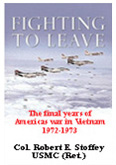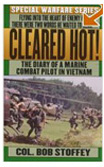|

| Colonel Robert Stoffey was the main speaker at the Palomar Airport (PAL) Hanger to a gathering of military personnel. Prior to his speech, his biography was given as an introduction. |
| After lunch, Denny Schafer introduced our speaker, Col. Bob Stoffey, a highly decorated and retired Marine Corps helicopter and fixed-wing pilot. During the first part of his talk, Bob noted he received his Gold Naval Aviator Wings in Pensacola and was then assigned to a Marine Corps helicopter squadron in Oppama, Japan in 1958. From Japan, his squadron was shipped to the Philippines for training with the Philippine Army. While there, they were demanded to leave the Island of Mindanao by local Muslim militants. After three days there, the Muslim militants produced a head on a pole of a missionary from England. Soon, the American State Department directed his squadron to leave the Philippines. They were sent to Laos, where they assisted the Royal Laotian Government Army fighting against the communist Pathet Laos. After only a month, they were directed back to Japan. In September of 1958, he was sent to Kaochung, Formosa as a SAR pilot in a helicopter during the Formosan Crises. While landing on Quemoy Island the Chinese communists shelled the islands of Quemoy and Matsu, and Bob and his helicopter came close to being blown up. After the calming of the Formosan Crises, Bob returned to Japan, and then was sent to Korea andfinally transferred to Okinawa in 1959. 1959, he was transferred to New River, NC and then in 1961, was sent aboard the USS Boxer, LPH-10 to off of Cuba to assist the Cuban anti-Castro forces invade Cuba. At the last hour, JFK canceled the American support and Castro forces chewed up the invading anti-Castro forces…the USS Boxer sailed by three days later to pick up some surviving defeated anti-Castro forces and took them to Viegues Island, Puerto Rico. The following year, 1962, Bob again sailed on the USS Boxer as a Forward Air Controller flying an OE-1 Bird dog to control Naval Gunfire, Close Air Support and Artillery support during the Cuban Missile Crises. At midnight the missions for the next morning’s attack upon Cuba were cancelled as JFK cancelled the invasion of Cuba because Kruchev agreed to pull out the Soviets missiles from Cuba. Cuba, Bob and his family was sent to Hawaii for a three-year tour. He flew helicopters and fixed-wing there, and in 1965, he was sent to Da Nang, Vietnam as a marine helicopter pilot, where he flew UH-1E gunships and H-34 transports. During1965-66, in Vietnam, Bob flew some hairy missions. One of the two times he was shot down he was totally surrounded by Viet Cong forces, and narrowly escaped by being rapidly picked up by his wingman. The VC then blew up his crippled helicopter after he departed in the wingman’s helo. Bob returned for a second of his three combat tours in 1969-70. He flew the OV-10A “Bronco” recon aircraft as a Forward Air Controller (FAC). During both tours, he flew a total of 440 combat missions. On one occasion, in his OV-!0A as a FAC, he controlled many flights of Air Force and Marine fighter attack aircraft in getting out a marine deep recon team that was totally surrounded by North Vietnamese Army troops. It took him two hours to bomb and clear a way out so a marine helicopter could get the troops by dropping a line for the eight-man unit to get plucked out. The helo then climbed out of the hot zone as eight marines hung on the rope and on take off the helicopter was 2,000 feet over the valley…what a sight of 8 troops on a rope at that altitude…like a circus act. Bob later, in 1971 returned for another tour of combat duty for two more years, or a total of four years in Vietnam. This time, Bob was the Assistant Amphibious Warfare Officer and Marine Air Officer on the staff of Admiral Mack, Commander 7th Fleet onboard the USS Oklahoma City, CLG-5 off North Vietnam. During Easter week of 1972, Bob was with Admiral Mack when the North Vietnamese invaded South Vietnam, after waiting one year after the U.S. had pulled all ground Army and Marine Corps fighting forces out of Vietnam in 1971. As a staff officer on the 7th Fleet Commander’s flag ship, Bob participated in some very unusual combat events during his two years aboard the USS Oklahoma City.
Some events he personally established and directed from the 7th Fleet, such as: -He directed the sailing of amphibious ship, USS Denver with 7 marineCobra AH-1G attack helicopters into the North Vietnamese waters off Hon La, after the U.S. Navy mining of Haiphong Harbor. The operation was called, MARHUK, marine hunter killer operation. The Cobra helos, day and night, attacked motorized junks that were bringing into North Vietnam ammunition and food. For nine months, the operation ran on as large Chinese communist merchant ships off-loaded supplies at anchor off Hon La, and the MARHUKs continued to sink the North Vietnamese waterborne logistics craft. When the Vietnam War ended, Bob sailed back to Japan on the Oklahoma City, and picked up his family to report to duty as the XO, then CO of Marine Reserve Air Group at Selfridge ANG Base, Detroit MI. Then, in 1975, he was assigned Commanding Officer of VM0-2 Observation Squadron at Camp Pendleton, CA for a year and a half. He then became Ops Officer, XO, and a short time CO of the Air Group. Following some special assignment at Headquarters Marine Corps, he returned to CampPendleton for two years on the staff of the Commanding General, I MarineAmphibious Force, Camp Pendleton, and retired in 1979. Among some of his military awards, Bob has Two DFCs, Navy-Marine Corps Medal for personal heroism, twenty-five Air Medals, Bronze Star, many other American medals, and the Republic of Vietnam Honor Medal and the Republic of Vietnam Air Cross of Gallantry. Bob then became the National Sales Manager for Rockwell International Integrated Circuits Division, later, the Sales Manager for Hughes Microelectronics, finally retired from Vice President of Litel, a laser machine manufacturing company. |
| The above biography was from a press release. |
| Information on books available - Click me |
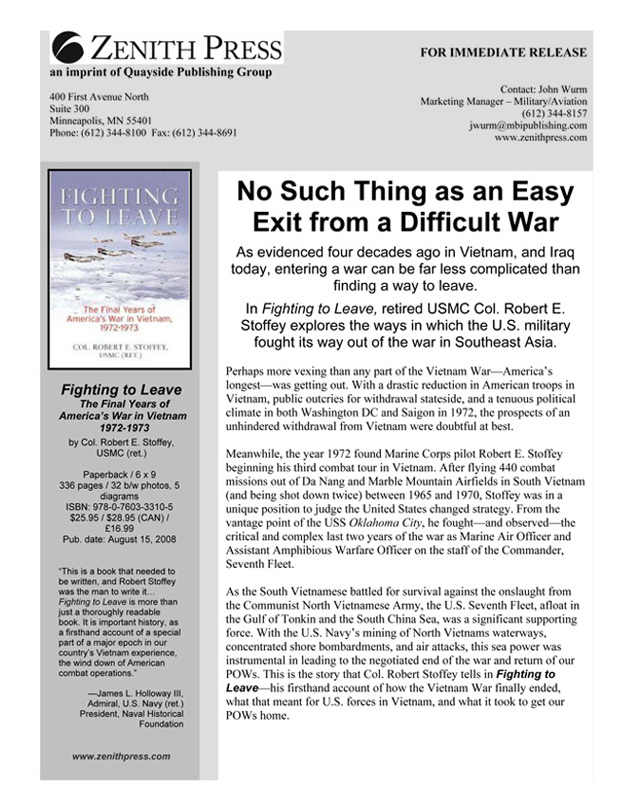 |
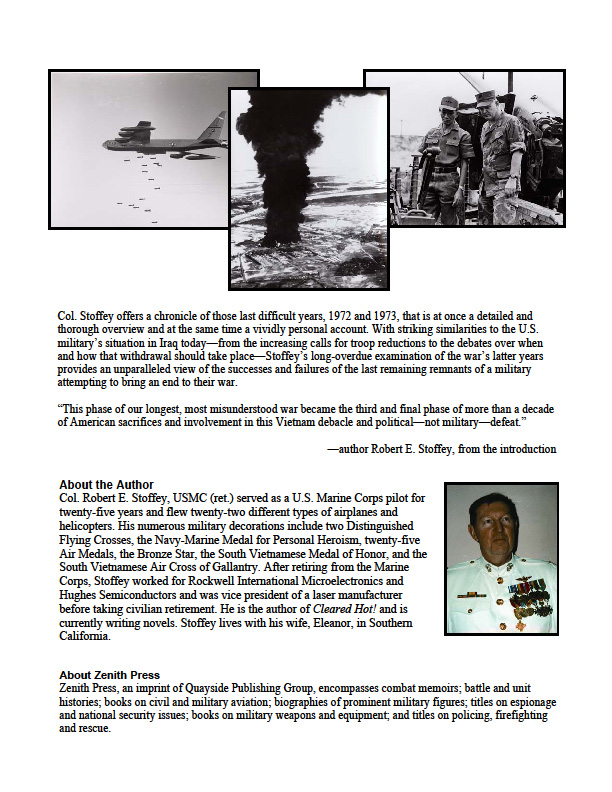 |
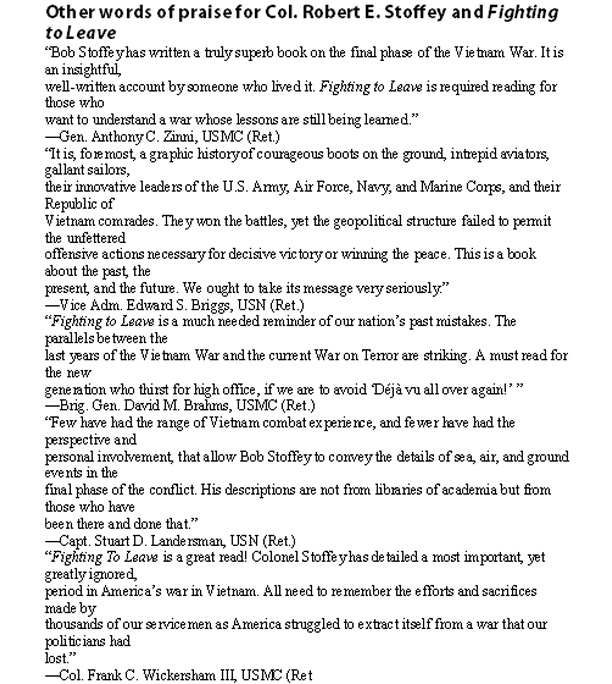 |
